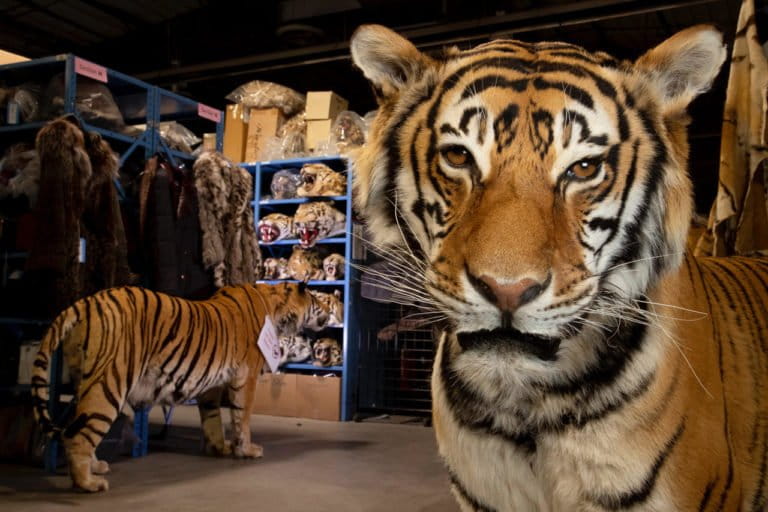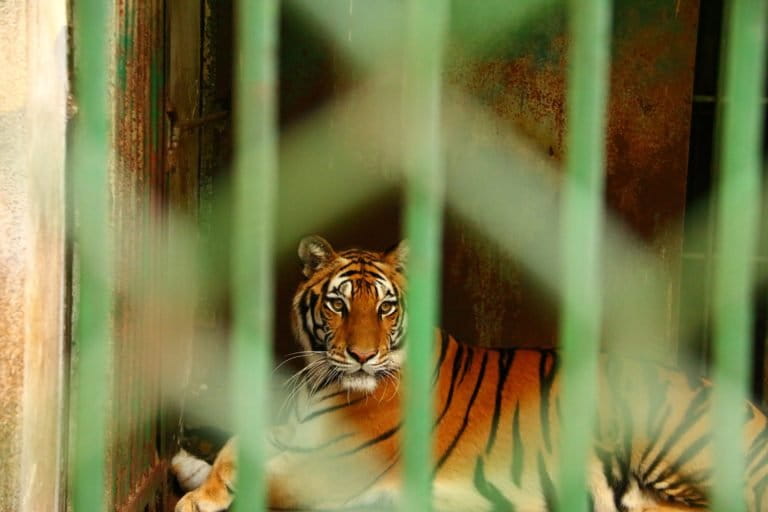- Americans may think that the illegal trade in tiger parts is half a world away but in reality, the U.S. is a large part of this lucrative global market.
- Recent research indicated the amount of tiger parts entering the U.S is likely much larger than previously reported, and raises questions about the demand for tiger parts within the U.S. plus the role of captive U.S. ‘pet’ tigers in the trade.
- The Big Cat Public Safety Act being debated in the Congress revises restrictions regarding the possession and exhibition of big cats in the country and should be supported, the authors argue: “It’s just a matter of time until the next pet tiger escapes and causes serious harm or death.”
- This article is a commentary. The views expressed are those of the authors, not necessarily of Mongabay.
After two seasons of the hit television show Tiger King and a new dramatization, Joe vs. Carole, soon to debut, millions of people have been desensitized to the dangerous and cruel issue of keeping big cats as pets.
Across the United States there have been more than 300 dangerous incidents involving big cats since 1990. In the last 10 years, “four children have lost their lives and dozens of others lost limbs or suffered other traumatic injuries. Sixteen adults have been killed, and scores have been mauled.”
Last February, a tiger escaped from a home in Bexar County, Texas and roamed through neighborhood backyards an event that was caught on camera and posted to TikTok. This county has also experienced a number of tiger seizures by law enforcement officials due to unlawful ownership.

But the problem of domestic tiger ownership isn’t unique to Texas. In September of 2020 in Knoxville, Tennessee a Knox County Sheriff’s Office deputy spotted a tiger “rise out of the water of the French Broad River, cross the street, and disappear into the woods.” In May 2021, global media covered the now infamous week-long incident of a missing tiger in Houston. While this gained worldwide attention, its occurrence wasn’t very surprising to those who have been paying attention to tigers in the U.S.
The problem expands far beyond just keeping big cats as pets. Animal welfare activists and wildlife trafficking experts argue that shows like Tiger King, which glorify petting, playing with, feeding, and shooting photo ops with cubs, stimulate big cat trafficking, specifically creating the incentive for people to capture big cats in the wild and/or breed them for the purpose of selling cubs.
To date, little research has examined the legal and illegal tiger trade in the U.S. Existing research has characterized a high demand for mammals – and specifically for big cat species – drawing attention to 941 seizures entering the US from 2003 to 2012. Estimates indicate there are as many as 10,000 tigers living in the U.S. either in zoos or privately owned – nearly double the estimated 4,981 tigers in the wild globally.
We wanted to know more and embarked on a deeper investigation of these dynamics in the U.S. specifically examining international legal and illegal tiger parts entering the country. Our results published in the journal Conservation Science and Practice indicate that the amount of tiger parts entering the U.S is likely much larger than what has been previously reported.
People in the U.S. have this false notion that the illegal trade in tiger parts is half a world away and only originates in far off lands. In reality, the trade remains a global, lucrative one and the U.S. is a large part of it.
See related: For the Year of the Tiger, a shared vision for the future of the iconic cat

Using U.S. federal government records, we identified a substantial number of illegal tiger parts entering the U.S. Tigers can also be legally traded internationally as an Appendix I species under the Convention on the International Trade in Endangered Species (CITES) with import and export permits for scientific, breeding, or educational purposes. We examined legal import permits for tigers and tiger parts and nearly half were for previously seized or confiscated animals. Records did not indicate whether legally traded items that were seized or confiscated ultimately came from the wild or were from captive-bred tigers. A notable number of both legal and illegal imports were sourced from the wild.
Our research raises many questions about the demand for tiger parts and captive tiger management within the U.S. If there was a high demand, which one could speculate there is based on the number of illegally imported tiger parts, it is possible that this demand was being supplied by captive tigers born and bred in the U.S. Today, Asia continues to be the main market for tiger parts and in 2016, a man was arrested for sending tiger skulls and claws from the U.S. to Thailand. A tiger penis itself is worth more than its weight in gold, and a whole tiger can be worth more than $350,000. Yet, there is currently no way to track captive tigers in the U.S., and many states lack laws and procedures to oversee the disposal of high-value tiger parts once these pets die.
What’s also lost is that wildlife trafficking has also been linked to national security concerns due to its integration with the trade in narcotics, arms, and humans. In addition, it has continued to threaten the survival of tigers, which now occupy a mere 5% of their historic range.
The news sounds bad, but there is a way to begin getting the problem under control.
The Big Cat Public Safety Act (H.R. 263 of the 117th Congress) was introduced to the U.S. House of Representatives by Mike Quigley (D-IL). It revises restrictions regarding the possession and exhibition of big cats – such as lions, tigers, leopards, cheetahs, jaguars, or cougars – in the country. A previous version of the bill had been voted favorably in December of 2020 in the House by a vote of 272 to 114, but it was not voted on by the Senate and died in the 116th Congress.
The current legislation faces a vote in the House and then the Senate. If adopted as a federal bill, it would amend the cornerstone wildlife trafficking bill – the Lacey Act – clarifying provisions enacted by the Captive Wildlife Safety Act in an effort to further the conservation of big cats and public safety.
See all of Mongabay’s coverage of big cats here

Right now, it is still legal to own a pet tiger in certain parts of the U.S. For example, 13 states simply require a big-cat permit, but three others – Alabama, North Carolina and Wisconsin – have no laws on keeping big cats as pets.
The Big Cat Public Safety Act would prohibit private individuals from owning big cats as well as prohibit the public from petting, playing and feeding them.
By cutting down on tiger tourist activities at non-accredited zoos, which incentivize the unnecessary breeding of tigers in the U.S., the BCPSA would ensure the country plays a positive role in global conservation efforts by enacting captive tiger regulations. It would also boost public safety by taking big cats, particularly tigers, out of the hands of untrained individuals. It’s just a matter of time until the next pet tiger escapes and causes serious harm or death.
To track this bill, contact your representatives or learn more, visit its GovTrack page.
Monique Sosnowski is pursuing a doctoral degree in criminal justice at the John Jay College of Criminal Justice/CUNY.
Sarika Khanwilkar is the founder of Wild Tiger, a nonprofit whose mission is to conserve India’s Bengal tigers and their habitats, and is also pursuing a doctorate in ecology from Columbia University’s E3B program.
Related listening: Mongabay’s podcast explores the effect of infrastructure projects on key wildlife like the last Sumatran tigers, listen here:
Citation: Sarika Khanwilkar, Monique Sosnowski, Sharon Guynup (2022). Patterns of illegal and legal tiger parts entering the United States over a decade, 2003–2012. Conservation Science and Practice.
doi:10.1111/csp2.622
Disclosure: One of the study authors, Sharon Guynup, has contributed reporting to Mongabay on a freelance basis.